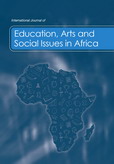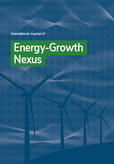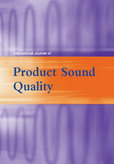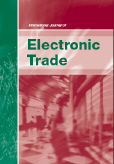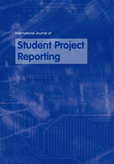Explore our journals
Browse journals by subject
Research picks
- Shore thing – coastal costs of climate change
A review in the International Journal of Environment and Pollution has looked at research into the impact of climate change on the coastal environments of small islands. The study covers the literature from 1985 to 2021, and offers new insights into the deleterious effects of human activities on small island coasts. Lorenzo Carlos Quesada-Ruiz of the University of Seville and Carolina Peña-Alonso of the Universidad de Las Palmas de Gran Canaria, Spain, examined more than 500 papers, which focused broadly on North Atlantic and North Pacific islands and highlighted the effects of various human activities on ecosystem services.
Human actions, including climate change, environmental policy, and tourism, have been identified as important factors that are detrimentally affecting delicate ecosystems. Factors such as increasing populations, technological advancements, and an increase in tourist activities have put increased pressure on small island coastal regions in many different ways. This pressure has disrupted ecosystem balances and led to increased vulnerability to natural disasters and climate extremes.
In addition, the review shows that of major concern are habitat loss, biodiversity decline, shoreline alterations, and landscape degradation. Activities like maritime trade, fishing, agriculture, urbanization, and infrastructure development have exacerbated the problems and pose ongoing threats to both ecosystems and local populations. Moreover, the looming threat of climate change, with its projections of sea level rise and more frequent extreme storm events, will further compound the vulnerabilities, particularly for islands that have dense coastal populations.
In their review, Quesada-Ruiz and Peña-Alonso emphasize the importance of understanding the complex interactions between human activities and coastal ecosystems with a view to developing effective mitigation strategies to manage the worst effects.
For some areas, marine litter, extractive activities, and the lack of management of protected areas, remain underexplored in the research literature. The team points out that there are also methodological gaps, including limited integration of Integrated Coastal Zone Management (ICZM) and sparse utilization of data-driven models. This, their review suggests, highlights the need for more comprehensive approaches to coastal environmental research.
Quesada-Ruiz, L.C. and Peña-Alonso, C. (2023) 'Studies of environmental coastal impacts in small islands: a review', Int. J. Environment and Pollution, Vol. 72, Nos. 2/3/4, pp.99–128.
DOI: 10.1504/IJEP.2023.137972 - Double-oh yes!
The year 2022 saw the death of composer Monty Norman, perhaps best known for the iconic James Bond theme. 2022 also marked the 60th anniversary of the James Bond film franchise itself with Dr No being the first in a long list of films to use Norman's psychedelic big band sound with the twangy guitar. That same year also saw a legal precedent being set by the European Union Intellectual Property Office (EUIPO) in the world of trademarks. US company Danjaq LLC which holds the copyright for the James Bond film franchise successful registered a segment of the James Bond theme as a trademark.
This trademark decision reflects the evolving nature of intellectual property protection, especially concerning audio branding in the film industry. By securing a trademark for this well-known portion of the original James Bond theme, Danjaq LLC, has shown just how important music and sounds can be for branding.
Writing in the International Journal of Intellectual Property Management, Alexandros Antoniou of Essex Law School at the University of Essex in Colchester, UK discusses the intricacies of trademark law and how this particular case played out, legally speaking. He points out that for a sound to qualify as a trademark, it must be distinctive enough that the average consumer associates it exclusively with a particular source. Common sounds, such as the two-tone chime of a doorbell or the sound of a cuckoo clock, usually do not reach this legal threshold and so cannot be trademarked. Conversely, aural themes that much longer are usually protected by copyright as creative works. The familiar snippet of the James Bond theme associated with the fictional spy with the licence to kill is recognised around the world and has a strong association with the film franchise. It is sufficiently long as to be non-trivial and short enough to meet the criteria of a sonic trademark.
Of course, a creative work, even rendered as a snippet, is also covered by copyright law so that nobody can use said work without the appropriate permissions from the holder of the copyright. The dual protection of the James Bond theme through both copyright and trademark law gives the owners of this intellectual property even greater advantages. Copyright protects the original creative work, granting exclusive rights to the creator for a limited period—the creator's life plus 70 years. The trademark protection can be renewed indefinitely, potentially allowing perpetual control over this musical snippet. The owner's of the film franchise can therefore safeguard their sonic identity against unauthorized use and exploit it for profit or other ends almost in perpetuity with legal protection with a view to making a killing. The legal spectre suggests that it's not only diamonds that are forever, after all.
However, adds Antoniou, the overlap of trademark and copyright protections raises important questions about the balance between protecting intellectual property and fostering cultural innovation. Copyright law aims to promote creativity by eventually releasing works into the public domain, while trademark law can extend protection indefinitely, potentially limiting access to cultural works. The legal decision regarding the James Bond theme highlights the need for careful regulation to prevent the abuse of trademark rights, ensuring they do not stifle creativity and innovation.
Antoniou, A. (2024) "The registration of an iconic movie theme as a trade mark: only 'diamonds are forever'", Int. J. Intellectual Property Management, Vol. 14, No. 3, pp.300–308.
DOI: 10.1504/IJIPM.2024.138332 - Influencing the influencers
A study in the International Journal of Electronic Marketing and Retailing has provided new insights into social media influencers, particularly focusing on those in the women's fashion sector on the well-known image and video sharing platform Instagram. In a departure from the approach taken by earlier studies, Jens K. Perret of the International School of Management in Cologne, Germany, has used network statistics and centrality measures to establish a model of influencer importance within their network.
Perret analysed data from 255 influencers covering a four-year period. Influencers are loosely defined as individuals, or even companies, that have a significant online presence and influence on one or more social media platforms. They typically have a large number of followers and a high level of engagement with that audience in terms of their sharing of content and approval by their fans. Topics such as fashion, beauty, lifestyle, fitness, and gaming have many prominent influencers. Influencers often work with brands to promote products or services to their followers, and so can have an important effect on marketing strategies for companies.
The work has found four main factors contributing to an influencer's significance: followers, reach, engagement rate, and posting frequency. Through regression analysis and artificial neural networks, Perret examined just how consistent these factors were in affecting the influencer's relationships.
The practical implications of the work are that it offers a methodology for evaluating an influencer's importance using readily available metrics. This could streamline the influencer selection process for companies seeking to recruit influencers for their marketing campaigns. It also provides solid evidence that could be used in fair compensation negotiations between companies and influencers.
While the study focused on Instagram, the same approach could work just as well with other social media platforms and even in other cultural contexts. This could open up the possibility of related research into social media dynamics and influencer marketing.
Perret, J.K. (2024) 'Who influences the influencer – a network analytical study of an influencer's peer-based importance', Int. J. Electronic Marketing and Retailing, Vol. 15, No. 3, pp.370–392.
DOI: 10.1504/IJEMR.2024.138301 - Hydrogen takeoff
As technologists search for approaches to reduce our global carbon footprint and stave off the worst ravages of climate change, they are turning to an old friend – hydrogen. The potential of hydrogen fuel cells for generating power is enormous although not without issues. Writing in the International Journal of Sustainable Aviation, a team from the UK and Romania discusses hydrogen-powered aircraft. The concept of replacing carbon-rich jet fuel with zero-carbon hydrogen is high on the agenda.
The team has compared the performance of a regional aircraft, the ATR 72-600, using three different propulsion systems: conventional jet fuel, direct hydrogen combustion, and hydrogen fuel cells. Bassam Rakhshani and Tony Leslie of the University of the West of Scotland in Paisley, UK, and Alexandru Stan of Premium Aerotec Ghimbav (Airbus) in Romania used Simulink, a computational tool, to model and analyse power requirements, fuel consumption, propulsion efficiency, and emissions.
The findings show that hydrogen propulsion, either through direct combustion in a jet engine or using fuel cells, reduces fuel mass significantly. Specifically, hydrogen fuel cells achieve a 50% reduction, and direct hydrogen combustion an 80% reduction compared to traditional jet fuel. This efficiency is attributed to hydrogen's higher energy density when compared to conventional jet fuel. However, the researchers also found a significant drawback: the increased weight from hydrogen storage, which negatively impacts overall aircraft performance.
The aviation industry is estimated to contribute 2-3 percent of global carbon dioxide emissions, and that percentage is set to double by 2050. There thus remains an urgent need to make aviation more sustainable. As it stands, hydrogen propulsion, alongside electric propulsion, could be the answer, but new technology is needed to overcome that storage weight-gain problem in order to achieve near-zero aircraft carbon emissions.
The transition to hydrogen-powered aircraft has other challenges: shorter operational ranges with current technology, lower passenger capacity, higher operational costs, and the need for new refuelling infrastructure. There are also the safety issues to consider. Nevertheless, the companies are looking at how they might retrofit their aircraft. It is possible that the development of novel storage systems might address some of these issues.
Rakhshani, B., Stan, A. and Leslie, T. (2024) 'A steady-state model-based evaluation of performance characteristics and feasibility analysis of retrofit hydrogen-powered aircraft configurations', Int. J. Sustainable Aviation, Vol. 10, No. 2, pp.99–123.
DOI: 10.1504/IJSA.2024.138699 - Technological food security
Research in the World Review of Entrepreneurship, Management and Sustainable Development discusses how the integration of advanced technologies such as the Internet of Things (IoT), Artificial Intelligence (AI), big data, and cloud computing can bring about significant change in agriculture. This point is particularly relevant in South Korea, where there is a growing demand for affordable, nutritious, and healthy food.
The research by Sean Watts of the International Business Keimyung Adams College at KeiMyung University in Daegu, South Korea, and colleagues in Australia, South Korea, Taiwan, and Vietnam, focuses on Samsung as a leading player in IoT and the role it might play in improving efficiency and sustainability in agriculture.
The team has taken a mixed-methodology approach, including qualitative action-based research, to investigate how a company might expand its IoT services into South Korean agriculture. Surveys conducted with representatives from the South Korean Farmers' Agricultural Association (Nonghyup) identified four promising IoT-based smart grid initiatives. The research points out that despite Samsung's strong brand presence and the potential benefits of IoT, its use in South Korean farming is still limited and not yet widely recognized.
The combination of AI and IoT could lead to new opportunities for a company well positioned to support farmers in their quest for improved efficiency and the demands of sustainability given the environmental and socioeconomic issues we currently face globally. There is also the potential for consumers to use technological advancements to grow their own food in kitchen gardens and on allotments more effectively. This would extend the benefits of IoT technology well beyond conventional farming environments.
Globally, a lack of food security affects almost 700 million people where they lack easy and affordable access to sufficient, nutritious, and safe food, according to the Food and Agriculture Organization of the United Nations. In Asia, a grain deficit of 10.8 million tonnes has resulted in well over 300 million people facing food insecurity, a crisis surpassed only by Sub-Saharan Africa. If the global population expands by 1.7 billion by the year 2050, the pressure on food production resources will worsen. Technological solutions might be the only way to continue to put food on the table.
Watts, S., Hoa, N.T.T., Martens, W., Doan, D.T. and Guzman, A. (2024) 'An examination of internet of things in the South Korean agricultural industry: the case of Samsung', World Review of Entrepreneurship, Management and Sustainable Development, Vol. 20, No. 3, pp.374–396.
DOI: 10.1504/WREMSD.2024.138282 - Navigating the digital silkroad
The Digital Silk Road (DSR) an economic initiative launched by China in 2015 is a key component of the country's broader Belt and Road Initiative (BRI). Its primary aim is to extend China's influence through digital and technological means globally, including the Central and Eastern Europe region, the CEE.
Research by Ágnes Szunomár of the Corvinus University of Budapest and Institute of World Economics in Hungary in the European Journal of International Management has looked at how the initiative seeks to integrate Chinese technologies and standards into the digital ecosystems of various countries. Ultimately, the DSR will open up new markets around the world to Chinese companies. Szunomár's work shows how this expansion has been met with a mixed response across the CEE. Of concern are the balance of economic, political, and security considerations facing the region as China expands its global reach.
One of the major concerns surrounding the DSR is the increased involvement of Chinese companies in the development, installation, implementation, and maintenance of critical digital infrastructure. European countries are concerned that there could be not only a loss of industrial competitiveness, but increased dependence on China. Moreover, there is the worry that the Chinese government may well have ultimate control of such companies. There are thus national security issues to be considered as well as lower-level, but important, threats to privacy and security at the industrial and personal level. Given the potential for China to have control over the flow of data through the infrastructure its companies build these concerns may well be warranted.
The research touches on the growing economic presence in Europe of Chinese companies over the past two decades. Indeed, the European Union (EU) has designated China as a systemic rival. Although across the broader CEE, reactions to the DSR and Chinese technology companies varies enormously. Many CEE countries share the general European and, indeed, American concerns about Chinese influence. However, Hungary and Serbia are I seems more accepting and receptive to Chinese investment and technology. These countries see the low-cost telecommunications equipment offered by Chinese firms as presenting them with an opportunity for greater national economic growth and technological advancement.
In contrast, Czechia, Estonia, Poland, and Romania are among the more sceptical of Chinese advances and in some ways are in outright opposition. These countries are aligned more closely with the US and EU positions, in particular on the notion of digital sovereignty and cellular broadband, 5G, security.
Szunomár has looked at why there are such disparate responses to Chinese advances. Inevitably, those countries that prioritize security concerns and are aligned with the US and EU stance, tend to show greater opposition to the involvement of Chinese technology. The counties that are happy to take the perceived risks in favour of economic advancement are thus emboldened to accept greater participation from China in their technological affairs.
Szunomár, Á. (2024) 'To connect or not to connect? Responding to the Digital Silk Road in Central and Eastern Europe', European J. International Management, Vol. 23, Nos. 2/3, pp.344-363.
DOI: 10.1504/EJIM.2024.138658 - Graded grains make finer materials
A study from Japan published in the International Journal of Computer Aided Engineering and Technology reveals a way to optimize the composition of functionally graded materials (FGMs). FGMs are advanced composite materials with a gradual variation in composition and properties across their volume, designed to optimize performance under specific loading conditions. The work could be used to mitigate residual thermal stress in uniformly cooled, multi-layered FGM plates allowing them to cope better with the significant thermal cycles found in aerospace applications and in the power generation industry.
Ryoichi Chiba of the Department of Mechanical Engineering at Sanyo-Onoda City University has used what are referred to as black-box optimization (BBO) techniques within the open-source framework Optuna to carry out the investigation. Optuna is known as a user-friendly interface, ideal for complex such optimization tasks. Chiba has used three Optuna algorithms: the tree-structured Parzen estimator (TPE), the covariance matrix adaptation evolutionary strategy (CMA-ES), and the non-dominated sorting genetic algorithm II (NSGA-II). Each of these algorithms offers a unique approach to optimization, with TPE focusing on rapid convergence, and CMA-ES and NSGA-II on evolutionary strategies.
The optimization of FGMs has always proved a tough task as there are so many variables at play in their design and production any one of which might have a significant positive or negative impact on their properties. Chiba explains that the CMA-ES algorithm worked best. While TPE converged quickly on a solution, its optimization quality was not as high as the more thorough evolutionary approaches of CMA-ES and NSGA-II. There were, the work shows, problems that can arise in attempting to account for interactions between design variables that were sometimes counterproductive leading to a more complicated optimization rather than an enhanced process.
Chiba, R. (2024) 'Comparing open-source optimisation algorithms for functionally graded material design: a thermoelastic case study', Int. J. Computer Aided Engineering and Technology, Vol. 19, No. 1, pp.1–12.
DOI: 10.1504/IJCAET.2024.138652 - Searching the talkies
A new approach to searching through video content has been developed by a team in South Korea. The system, described in the International Journal of Computational Vision and Robotics, extracts spoken word from a video recording, converts it to text, and then makes that text searchable. Importantly, the system thus does not rely on embedded keywords nor curated tags or hashtags to be associated with the video content.
The approach obviously relies on the dialogue or spoken commentary of an item being associated with the scenes in the video that users might wish to search. It is, of course, superfluous if the video has subtitles already baked in. Nevertheless, it will be a boon for users wishing to search the millions of hours of video available in databases, on streaming services, and elsewhere on the internet and could be used to help catalogue videos.
Kitae Hwang, In Hwan Jung, and Jae Moon Lee of the School of Computer Engineering at Hansung University in Seoul, have developed an Android app for use with appropriate smartphones. It is worth noting, however, that there is at least one other app with the same name, so should this app be made available in the Google Play Store for Android apps, it is likely to require a change of name.
The new app works by extracting audio from videos using the FFmpeg code and converting it into text in ten-second increments. This, the team explains, creates a searchable timeline for the video. Advanced speech recognition technology then generates a transcription of those audio segments, which are indexed on the video timeline. For a 20-minute video, the process is complete in just two to three minutes and runs in the background while the video plays. The team points out that users can then search for specific terms and find all mentions in the video.
The app will have applications in education, news analysis, and other information-dense video where quick access to specific information is needed. For instance, students reviewing lecture recordings or journalists searching for specific statements in interviews could make use of this app. There are many more scenarios where it would be useful to be able to search video in this manner.
Hwang, K., Jung, I.H. and Lee, J.M. (2024) 'An implementation of searchable video player', Int. J. Computational Vision and Robotics, Vol. 14, No. 3, pp.325–337.
DOI: 10.1504/IJCVR.2024.138324 - Chasing greener pavements
Could permeable and high-albedo materials for road surfaces that replace asphalt across towns and cities reduce the urban heat island effect at the height of summer as well as reducing the risk of flash floods and groundwater depletion? An idea in the International Journal of Student Project Reporting hopes to answer that very question.
Julianna Syros, Alexander Villiers, Ginger Arnold, Bryan De La Paz, and Trevor Fai of the University of Florida in Gainesville, Florida, USA, allude to how urbanization has become synonymous with progress, bringing with it modern amenities, economic growth, and improved living standards. However, this expansion has brought with it serious environmental challenges, notably flash floods, groundwater depletion, and the Urban Heat Island (UHI) effect. These issues largely arise from the extensive use of impermeable materials like asphalt in road construction, revealing a critical need to rethink our choices when it comes to transport infrastructure.
Asphalt is relatively low cost when compared to concrete and so has become the primary material used in road surfacing in urban areas the world over. However, this preference comes at a significant environmental cost. The impermeable nature of asphalt prevents rainwater from being absorbed into the ground, leading to rapid runoff and flash floods. This runoff can carry pollutants to water bodies and also hinders groundwater recharge, depleting vital water resources.
Moreover, asphalt's heat-absorbing properties contribute to the heat island effect. This effect sees urban areas experiencing higher temperatures than their rural counterparts, a problem that will become increasingly worrying as global temperature rises through climate change. The phenomenon is largely driven by the high density of heat-absorbing surfaces, such as roads and buildings, which trap heat and only slowly release it from the "island" as a whole. For towns and cities in hot countries and those facing increasingly common temperature spikes, the effect is to increase urban energy demands as those living and working there rely more and more on air conditioning to keep cool. Those without access that luxury will suffer the heat, which could lead to health problems and increased fatalities among the vulnerable during a heatwave.
Concrete, despite its higher upfront cost, presents a viable alternative with long-term benefits. Unlike asphalt, concrete is more durable and requires less maintenance, leading to lower costs over its lifespan. Furthermore, concrete can be designed to be permeable, allowing water to percolate through and recharge groundwater, thereby mitigating flash floods. High-albedo (reflective) concrete surfaces can also reflect more sunlight, reducing heat absorption and alleviating the UHI effect.
The team suggests that overcoming the societal and economic barriers are essential if sustainable transport infrastructure is to be developed to address the increasingly detrimental effects of urbanization. Investment may well attract greater initial costs, but in the long-term fewer flash floods, conservation of groundwater resources, and a significant reduction in the heat island effect would offer immediate payback when compared to sticking to asphalt.
Syros, J., Villiers, A., Arnold, G., De La Paz, B. and Fai, T. (2024) 'A study on high albedo permeable pavement reducing urban heat islands, flash floods and groundwater depletion', Int. J. Student Project Reporting, Vol. 2, No. 1, pp.1–20.
DOI: 10.1504/IJSPR.2024.137963 - Art for AI's sake
A comprehensive survey by a team from Croatia in the International Journal of Student Project Reporting, has looked at the intersection of art and artificial intelligence (AI). The team has focused on how AI technologies are employed in the classification and also the creation of artworks. Andrej Šimić and Marina Bagić Babac of the Faculty of Electrical Engineering and Computing at the University of Zagreb have analysed and categorised a number of research papers in this field to understand the methodologies, techniques, and outcomes in this emerging field. They discuss the two main applications of AI in art: the automated analysis of existing artworks and the generation of new ones.
AI-based art classification involves using machine learning algorithms to categorise artworks by attributes such as genre, style, and artist. This automated classification improves the ability of art historians and collectors to identify and categorise artworks with greater accuracy and efficiency. Techniques such as convolutional neural networks (CNNs) have been key in achieving high accuracy in these classification tasks, the team reports. CNNs can identify subtle patterns and features that might be challenging for human analysts to discern, providing deeper insights into the artistic attributes of different works.
In terms of art creation, the survey explores innovative AI-driven techniques such as style transfer, Generative Adversarial Networks (GANs), and text-to-image synthesis. Style transfer allows an image to be reinterpreted in the style of another, facilitating creative explorations and new artistic expressions.
GANs, the team explains, consist of two neural networks working together to generate realistic images. They enable the creation of "novel" artworks with intricate details and often a high degree of realism. Text-to-image synthesis offers a different approach where the AI generates images based on a prompt describing what the user would like to see. This can allow an almost seamless translation of ideas into the visual form.
The integration of AI in art has several implications. For art analysis, it democratizes access to art historical research and enhances the precision of art authentication and valuation. For art creation, AI provides artists with new tools and sources of inspiration, potentially expanding the scope of creativity. The ability of AI to generate art also raises questions about authorship and originality, challenging traditional notions of creativity. Indeed, the issues of copyright, permissions and plagiarism are high on the agenda in this area and have not yet been settled to everyone's agreement.
Šimić, A. and Bagić Babac, M. (2024) 'Artificial intelligence in classifying and creating art: a survey', Int. J. Student Project Reporting, Vol. 2, No. 1, pp.59–89.
DOI: 10.1504/137964
News
International Journal of Business and Emerging Markets is now an open access-only journal
We are pleased to announce that the International Journal of Business and Emerging Markets is now an Open Access-only journal. All accepted articles submitted from 15th May 2024 onwards will be Open Access, and will require an article processing charge of US $1600.
Prof. Gustavo Alonso appointed as new Editor in Chief of International Journal of Low Radiation
Prof. Gustavo Alonso from the National Institute of Nuclear Research in Mexico has been appointed to take over editorship of the International Journal of Low Radiation.
International Journal of Mechatronics and Manufacturing Systems' editorial team calls for papers
The following invitation comes from Prof. Tuğrul Özel, Editor in Chief of the International Journal of Mechatronics and Manufacturing Systems, and his editorial team:
We are the editorial team of the International Journal of Mechatronics and Manufacturing Systems (online ISSN 1753-1047; print ISSN 1753-1039), which is a peer-reviewed journal that publishes four issues per year including open-access articles. We are calling for papers for Vol. 17 No. 4 of the journal, and cordially invite you to submit your manuscripts.
You can view the journal's profile here. Instructions on how to submit papers are available under the Submitting Articles tab on this journal webpage. Free sample articles from the journal are available here.
The International Journal of Mechatronics and Manufacturing Systems is indexed by Scopus, Compendex, Academic OneFile (Gale), cnpLINKer and Expanded Academic ASAP, among others. It has a CiteScore of 1.7 (2022).
Please feel free to share this invitation with your colleagues and associates.
For any queries, please contact Prof. Tuğrul Özel at ozel@rutgers.edu
Best regards,
Editorial team
International Journal of Mechatronics and Manufacturing Systems
Associate Prof. Xin Wang appointed as new Editor in Chief of International Journal of Signal and Imaging Systems Engineering
Associate Prof. Xin Wang from Shenyang Jianzhu University in China has been appointed to take over editorship of the International Journal of Signal and Imaging Systems Engineering.
International Journal of Entrepreneurship and Small Business indexed by Clarivate's Emerging Sources Citation Index
Inderscience is pleased to announce that the International Journal of Entrepreneurship and Small Business has been indexed by Clarivate's Emerging Sources Citation Index.
The journal's Editor in Chief, Prof. Leo Dana, thanks his editorial board and IJESB's reviewers for the parts they played in reaching this significant milestone, as well as all the authors who've submitted their research to the journal.
